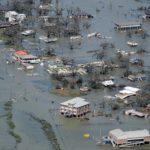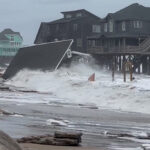The National Hurricane Center says the center of what is now Hurricane Isaac may make landfall on the southeast Louisiana coastline as early as this evening.
Not all forecasters share that timeline, however. Dr. Tim Doggett, principal scientist at AIR Worldwide, says the hurricane’s eye will more likely hit the coastline around 8 a.m. on Wed., Aug. 29.
Either way, the hurricane, which is now packing maximum sustained winds of 75 mph, is on a northwesterly track toward the mouth of the Mississippi River, the NHC reports.
Significant flooding from storm surge and rainfall is expected.
At midday on Aug. 28, the storm was located about 75 miles south-southeast of the mouth of the Mississippi River and about 160 miles to the south-southeast of New Orleans, according to AIR Worldwide.
“Isaac’s sustained winds have increased to 75 mph and the storm, as expected, is now a hurricane,” said Dr. Tim Doggett, principal scientist at AIR Worldwide. “Data from Hurricane Hunter aircraft indicate that maximum winds are closer to the storm’s center. These data also indicate that the storm has wobbled on a generally westward course during the past few hours, which is expected to be a temporary deviation from its northwestward movement.”
Doggett says Isaac’s forward momentum has slowed, which may mean storm will remain over water six to 12 hours longer than previously expected.
“The center of the storm should come on shore about 8:00 a.m. tomorrow and push inland over New Orleans during the day. Given this track and the slow forward speed, surge into Lake Pontchartrain is still a threat, even if Isaac remains only a marginal hurricane,” Doggett says.
Once on land Isaac will likely veer to the north/northwest and move into the Ohio Valley region, according to AIR Worldwide.
AIR estimates the total insured exposure (buildings) in coastal counties within Isaac’s expected impact area (within the NHC cone of uncertainty) totals USD 480 billion, or roughly 21 percent of the insured exposure in the three states (Louisiana, Mississippi, Alabama) altogether.
According to AIR, dangerous storm surges of up to 12 feet, heavy rainfall of up to 20 inches in areas, and strong winds are expected to extend well away from the center and to affect a large portion of the northern Gulf Coast. Heavy rainfall and flooding are also expected to spread inland over the Lower Mississippi Valley region during the next few days.
| 10 Costliest Hurricanes in Terms of Overall Losses (Munich Re) | |||||
| U.S. $Mil. Original Values | |||||
| Period | Event | Affected Area | Overall Losses | Insured Losses | Fatalities |
| 8/25-30/2005 | Hurricane Katrina | USA: LA, New Orleans, Slidell; MS, Biloxi, Pascagoula, Waveland, Gulfport | 125,000 | 62,200 | 1,322 |
| 9/6-14/2008 | Hurricane Ike | USA, Cuba, Haiti, Dominican Republic, Turks and Caicos Islands, Bahamas | 38,300 | 18,500 | 170 |
| 8/23-27/1992 | Hurricane Andrew | USA: FL, Homestead; LA; Bahamas | 26,500 | 17,000 | 62 |
| 9/7-21/2004 | Hurricane Ivan | USA, Caribbean, Mexico | 23,000 | 13,800 | 125 |
| 10/19-24/2005 | Hurricane Wilma | USA, Bahamas, Cuba, Haiti, Jamaica, Mexico | 22,000 | 12,500 | 42 |
| 8/11-14/2004 | Hurricane Charley | USA, Cuba, Jamaica, Cayman Islands | 18,000 | 8,000 | 36 |
| 9/20-24/2005 | Hurricane Rita | USA: FL, Keys; LA, Lake Charles, Holly Beach, Cameron, New Orleans; MS; TX | 16,000 | 12,100 | 10 |
| 9/20-29/1998 | Hurricane Georges | USA: LA, MS, AL, FL. Caribbean | 13,280 | 4,310 | 4,000 |
| 9/1-9/2004 | Hurricane Frances | USA, Bahamas, Canada, Turks and Caicos Islands, Cayman Islands | 12,000 | 5,500 | 50 |
| 8/21-9/3/2008 | Hurricane Gustav | USA, Cuba, Jamaica, Dominican Republic, Haiti | 10,000 | 3,500 | 139 |
| © 2012 Münchener Rückversicherungs-Gesellschaft, Geo Risks Research, NatCatSERVICE | |||||
Was this article valuable?
Here are more articles you may enjoy.


 AIG Promotes 3 to Lead North America Commercial as Bailey Retires
AIG Promotes 3 to Lead North America Commercial as Bailey Retires  Florida Reforms Are Truly Making a Difference, Gallagher Re Report Finds
Florida Reforms Are Truly Making a Difference, Gallagher Re Report Finds  Update: National Flood Insurance Program Expires
Update: National Flood Insurance Program Expires  More NC Outer Banks Homes Collapse into Surf as Hurricanes Stay Far Offshore
More NC Outer Banks Homes Collapse into Surf as Hurricanes Stay Far Offshore 

